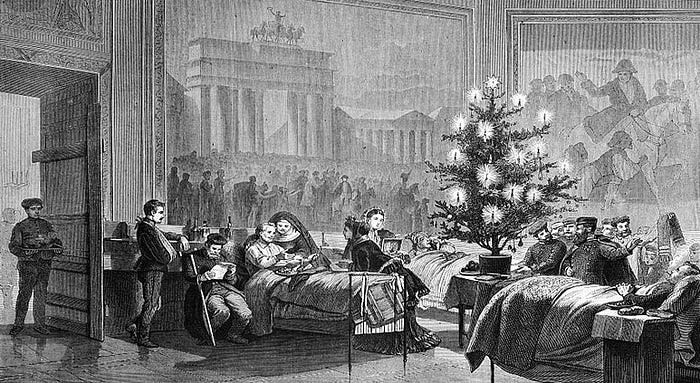O Tannenbaum (O Christmas Tree) — Another Song that has Very Little to Do with Christmas

Ernst Anschütz — 1824
Part of what makes Christmas music so interesting is its lack of any unified style. The only real rule for writing an enduring Christmas carol is it has to be memorable, but somewhere along the line a few hundred years ago composers started noticing they didn’t even need to start with a song about Christmas to make a new carol. A carol, assuming new lyrics were implemented well and an audience responded positively to it, could be based on melodies from other songs as long as they contained a solid hook. No one seemed to care! And without the technology we enjoy now, where a copycat song can be spotted and called out as soon as its released, a song’s history could be seemingly rewritten a century or two after its original composer had died. The 19th century carol “O Tannenbaum,” or as it’s more commonly known in the English-speaking world, “O Christmas Tree,” is one of those weirdo cases.
“O Tannenbaum” as we know it has two key credits from two different centuries: the composer of the melody, and the man that connected the song to Christmas.

The melody originates in the 16th century with folk songwriter Melchior Franck and his piece “Ach Tannenbaum,” a short tune about a fir tree in midwinter. Franck was a prolific composer credited with a great deal of Protestant church music and all-around pretty legendary writer, as he was also credited with bringing many of the musical innovations of the Venetian school north to Germany. Like a lot of music from the time, there aren’t really notes available on what compelled him to write the song, but given the tune’s reassuring melody, it probably didn’t have much to do with his entire family being killed by the typhus and the Thirty Years War.

Around 1819, a slightly edgier version popped up by German preacher, folk song collector, and fellow guy-with-warlock-name Joachim Zarnack repeating the imagery of an evergreen, this time to contrast with a tale of an unfaithful lover. Like the 2016 Ghostbusters reboot, this version didn’t win anyone over, so it wasn’t long before another version popped up, this one by Leipzig organist, teacher, and composer Ernst Anschütz in 1824. Anschütz penned a considerably less edgy and more famous set of lyrics, describing a tannenbaum as a symbol of endurance throughout the winter.
The original lyrics have absolutely no references to Christmas, but instead use the evergreen as a symbol of faithfulness and hope through the cold German winters. It does actually make sense that this version would take off as a Christmas song as the lyrics describe the tree as a symbol of spring and hope. “When winter days are dark and drear, You bring us hope for all the year. O Tannenbaum, O Tannenbaum, with what delight I see you!”
This is where the history of the Christmas tree makes this whole thing more interesting. The Christmas tree tradition as we know it originates in medieval Livonia (present day Latvia and Estonia) and early Germany where Protestants brought decorated trees into their homes. Some say Martin Luther was the first to do it, inspired by the starlight cutting through the branches on a brisk forest stroll on Christmas Eve, but Martin Luther gets credit for a lot of things and there’s very little proof of this one. These trees had a similar design to what we know today, featuring decorations like paper roses and tinsel, plus a bunch of food like apples, because I guess they forgot to fear rats. The idea was that in celebration of Christmas, the trees would be covered in sweets and brought into the town hall, where children could grab a bite while celebrating.

At the time Anschütz rewrote the lyrics to “O Tannenbaum,” German Protestants would have already connected the fir tree as a symbol of Christmas, making the tune a natural fit for the season. However, this wouldn’t have taken off in pretty well any other part of the world at the time. The Catholics to the south regarded the tree as a Protestant custom, and largely ignored it. It became culturally locked, and by the 19th century, it was considered an expression of German culture.

As the Protestant faith spread across Europe, more and more people became exposed to the custom, and before too long other people started to appropriate the tradition. European nobility started putting up trees in their homes around the holidays, popularised by figures like Princess Henrietta of Nassau-Weilburg in Vienna and the duchesse d’Orléans in France. Around this time, candles were also becoming common place on the trees, and before long those were replaced (for reasons obvious to anyone who’s ever watched National Lampoon’s Christmas Vacation) with electric lights.

In North America, the tradition first popped up in Québec in 1781 among a garrison of German soldiers stationed to ward off impending American attacks. The general and his wife held a Christmas party for the officers, and along with the sweets and dancing, a decorated tree made an appearance. Over the next hundred years, the tradition spread throughout the United States starting in cities with high German populations, and before long it became pretty common for anyone celebrating Christmas to put a tree in their houses.
As the tradition spread beyond German communities, the song followed, and so somewhere in the 19th century, the song was rewritten for Anglophonic Christians. By who? Weirdly there’s no clear author. “O Tannenbaum” doesn’t directly translate to “O Christmas Tree” at all; it seems to have just happened, most likely by an American priest or preacher.
Now what do you do when you have a super recognizable, catchy melody that people seem to really enjoy? You turn it into a bunch of other stuff. The melody of “O Tannenbaum” is so crazy famous, it ended up all over the place with new lyrics.
You know who really love this melody? Americans, and not two, not tree, but four different American States have used that melody as their state song. “Florida, My Florida,” “Maryland, My Maryland,” “Michigan, My Michigan,” and Iowa’s aptly named “The Song of Iowa” all use that tune, and though they aren’t all the official state songs anymore, it would have been a sight to see representatives from those four states fight over that melody. Several schools use the tune as well, including Cornell University and Trinity College at the University of Toronto, and of course, the melody showed up for Simpson’s snake-bashing holiday Whacking Day.
From a song about a tree, to a song about a Christmas tree, to a song about pretty much every state with a three-syllable name, “O Tannenbaum” proves that a catchy-enough melody can travel beyond cultural and religious confines, and to this day can be recognized around the world. Not bad, Melchior, not bad.
